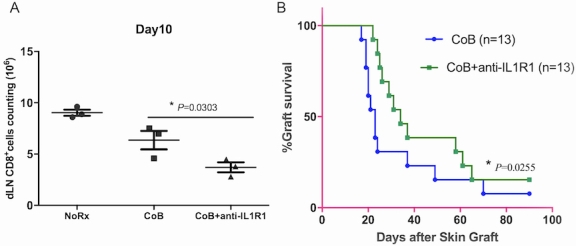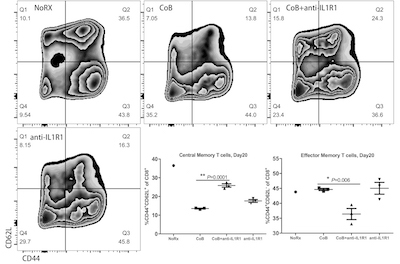Inhibition of IL-1R1 Signaling Delays Costimulation Blockade–Resistant Allograft Rejection by Preventing CD8 TEM Expansion
Department of Surgery, Emory University, Atlanta, GA.
Meeting: 2018 American Transplant Congress
Abstract number: C290
Keywords: Co-stimulation, Inflammation, Rejection, T cells
Session Information
Session Name: Poster Session C: Lymphocyte Biology: Signaling, Co-Stimulation, Regulation
Session Type: Poster Session
Date: Monday, June 4, 2018
Session Time: 6:00pm-7:00pm
 Presentation Time: 6:00pm-7:00pm
Presentation Time: 6:00pm-7:00pm
Location: Hall 4EF
The clinical utilization of Costimulaiton Blockade (CoB) led to improved long-term patient outcomes, but wider adoption of is hampered by increased rates of acute cellular rejection. IL-1 plays a critical role in a diverse tissues and cell types, and is known to augment immune responses, in particular CD8 T cells. We hypothesized that IL-1 signaling may support costimulation independent alloimmune responses, and tested whether treatment with an anti-IL-1R1 antibody with CoB could prolong graft survival.
C57BL/6 (H2b) mice recipients of skin grafts from BALB/c (H2d) mice received treatment with CoB (250 [mu]g anti-CD154 mAb [Bio X Cell, clone MR-1] and human CTLA-4-Ig [Bristol-Meyers Squibb]) and/or 200 [mu]g of hamster anti–mouse IL1R1 (Bio X Cell, Clone JAMA-147). All mAbs were administered i.p. on posttransplant days 0, 2, 4, and 6. The skin graft median survival were presented on Kaplan-Meier survival curves. After 10 days and 20 days, mice were sacrificed and spleen and dLN were collected. Collected cells were counted and FACS analyzed for CD4, CD8, CD44, and CD62L expression. Combination CoB+anti-IL-1R1 led to decreased absolute number of CD8+ T cells in the dLN (CoB+anti-IL-1R1 3.702±0.4888 vs CoB 6.358±0.9012, p=0.0303) and improved skin graft survival (Median survival, 34 days vs 23 days, p=0.0255,  ). At day20, the time of peak CoB independent rejection, the frequency of effector memory CD8+ T cells (CD44+CD62L-) was decreased significantly in the CoB+anti-IL-1R1 treated animals (CoB+anti-IL-1R1 36.40±1.850% vs CoB 44.63±0.3480%, p=0.006), whereas central memory CD8+ T cells (CD44+CD62L+) were increased (CoB+anti-IL-1R1 25.87±0.9244% vs CoB 13.53±0.2186%, p=0.0001) in the CoB+anti-IL-1R1 therapy, as compared to CoB alone, and untreated animals.
). At day20, the time of peak CoB independent rejection, the frequency of effector memory CD8+ T cells (CD44+CD62L-) was decreased significantly in the CoB+anti-IL-1R1 treated animals (CoB+anti-IL-1R1 36.40±1.850% vs CoB 44.63±0.3480%, p=0.006), whereas central memory CD8+ T cells (CD44+CD62L+) were increased (CoB+anti-IL-1R1 25.87±0.9244% vs CoB 13.53±0.2186%, p=0.0001) in the CoB+anti-IL-1R1 therapy, as compared to CoB alone, and untreated animals. 
CITATION INFORMATION: Liu Y., Dong Y., Mathews D., Ghosh A., Adams A. Inhibition of IL-1R1 Signaling Delays Costimulation Blockade–Resistant Allograft Rejection by Preventing CD8 TEM Expansion Am J Transplant. 2017;17 (suppl 3).
To cite this abstract in AMA style:
Liu Y, Dong Y, Mathews D, Ghosh A, Adams A. Inhibition of IL-1R1 Signaling Delays Costimulation Blockade–Resistant Allograft Rejection by Preventing CD8 TEM Expansion [abstract]. https://atcmeetingabstracts.com/abstract/inhibition-of-il-1r1-signaling-delays-costimulation-blockade-resistant-allograft-rejection-by-preventing-cd8-tem-expansion/. Accessed December 28, 2025.« Back to 2018 American Transplant Congress
